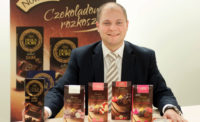Rübezahl
Schokoladen GmbH
Dettingen/Teck, Germany
Playful and progressive
According to one of many legends about Rübezahl, the spirit in the Giant Mounains, the fellow could be quite a prankster, sending snow or lightening from the mountain even when the sun was shining.
The namesake chocolate company, Rübezahl Schokoladen, which was founded by Josef Cersovsky in 1949, believes in being playful as well, although its intent is simply to delight consumers with a broad range of chocolate products.
Originally focused on producing chocolate bars, the company expanded to producing seasonal moulded chocolate figurines such as Santa Clauses and Easter bunnies. Subsequent generations continue to grow Rübezahl to the point where the company now turns out 30,000 tons of chocolate annually, operates three production facilities and posts €150 million annually.
Under the leadership of Claus and Oliver Cersovsky, Josef’s grandsons, the company has continued to expand its expertise in seasonal products while growing key brands, such as Gubor, Sun Rice, Friedel, Choco Gumis and Weseke Dragees in select chocolate segments.
Consider some of the annual production numbers regarding its seasonal business: 30 million Advent calendars; 50 million Santa Clauses; and 50 million Easter bunnies.
Having developed its own puffed rice product in 1994, Sun Rice, the company continues to pursue innovation as a means of delivering excitement to the market.
For example, after acquiring the Gubor brand in 2008, a long-revered premium component of the German chocolate industry, the company enlisted three-star Michelin chef Harald Wohlfart to create several new pralines under his supervision.
In doing so, the company garnered a Sweetie 2011 award and a Superior Taste Award with Two Stars from the International Taste and Quality Institute last year. The company also received the “Goldene Uhr des SG 2011” award for service to the German confectionery industry.
This year, the company has committed itself to using UTZ-certified chocolate for its Choco Gummis and Gubor brands as well as certain products from theFriedel range. Claus Cersovsky expects that nearly all of Rubezahl’s chocolate products will be using UTZ-certified cocoa by 2013.
The company also looks to new packaging for its Gubor line, touting the use of local ingredients from the Black Forest, such as cherries, raspberries, and yellow plum liqueurs.
Thanks to ongoing development, the company is ready to roll out its Choco Gummis product on a broad scale, the fine-tuning of proprietary technology now completed.
Viba Sweets GmbH
Schmalkalden, Germany
Hazelnut Heaven
Faced with adversity — be it high taxes, ingredient shortages or packaging challenges —confectioners often can be quite ingenious in devising alternative solutions to the problem at hand.
Take Italian manufacturers who — faced with high tariffs imposed on cocoa imports from America by the French in the 1800s — decided to use local ingredients, such as hazelnuts, to offset the higher cocoa prices.
In combining the two, the famed “gianduja” praline was born, a mouth-watering mix of hazelnuts, chocolate and sugar.
When Willi Viebahn, founder of Viba Sweets GmbH, had perfected the German equivalent, known as “nougat,” in 1920, he soon found a willing audience for the product.
In his attempt to find an automated way of packing the nougats, Viebahn picked up a second-hand cigar-packaging machine. In short order, the company began turning out round-shaped nougat bars, a trademark that characterizes Viba’s famed nougat products to this day.
Today, Schmalkalden, Germany-based Viba Sweets generates 70% of its sales from its line of nougat-based products, the remainder mostly from its fruit bar line. Having moved into a new production facility in 1997, the company has eight production lines.
In addition to manufacturing 40 different SKUs of nougat products, the company turns out 12 different varieties of fruit bars, 10 types of coated nuts and two different mints.
Its nougat praline was ranked as the No. 1 hazelnut praline in Germany. The marzipan varieties feature a high almond content, which reinforces the high quality nature of the company’s product line.
As decadent as Viba’s nougat products are, the company’s Fruit Bars deliver total health in snacking. The 25-gram fruit snacks, available in nine different flavors, feature extremely high real fruit content, ranging from 40% to as high as 86%, depending upon the variety. Sandwiched by two thin wafers, the fruit bars deliver exceptional fruit taste and health in a convenient format.
Come this February, the company looks to open Nougat World, a 2,500-sq.-meter complex featuring a flagship retail store, restaurant, showroom, a museum with interactive exhibition, a viewable mini-factory and learning center.
In addition, the site will feature a garden and the largest children’s playground in the region.
Wolfgang Lauterbach, online marketing and project manager, says the company expects 500 visitors daily, which would total 150,000 annually. Nougat World, which compromises only one part of the 50,000-sq.-meter site that features additional warehousing, was designed to resemble a Viba nougat.
The €15-million investment will create 50 new jobs in the area and is expected to become a key local attraction for the region. The company also operates 40 retail shops scattered throughout Germany.



